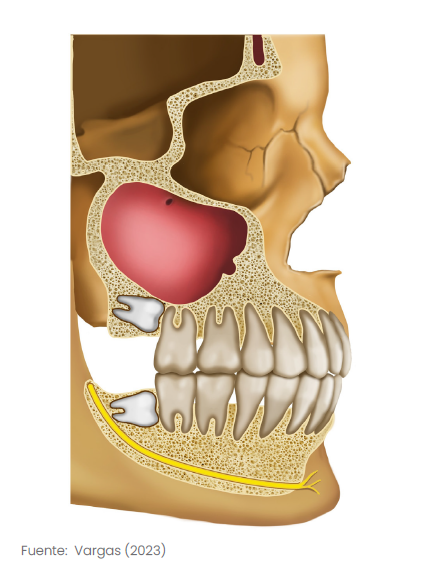Alternate classification for third molars
DOI:
https://doi.org/10.59334/ROV.v2i39.561Keywords:
wisdom teeth, classification, oral cavity, oral surgery, dentistryAbstract
Introduction: Different classifications of impacted wisdom teeth will be shown in adddition to a new categorization wich predicts their removal difficulty. Aim: The goal of the text is to create a guide for students and/or collegues to classify the degree of difficulty as a tool to measure the needed time to extract the tooth and the necessary steps to remove it and the related morbility.
Downloads
References
Abu Alhaija, E. S. J., AlBhairan, H. M. y AlKhateeb, S. N. (2011). Mandibular third molar space in different antero-posterior skeletal patterns. European Journal of Orthodontics, 33: 570–576. https://doi.org/10.1093/ejo/cjq125
Årtun, J., Thalib, L. y Little., R. (2005). Third molar angulation during and after treatment of adolescent orthodontic patients. European Journal of Orthodontics, 27: 590–596. https://doi.org/10.1093/ejo/cji049
Batista Camargo, I., Batista Sobrinho, J., De Souza Andrade, E. y Van Sickels, J. (2016). Correlational study of impacted and nonfunctional lower third molar position with occurrence of pathologies. Progress in Orthodontics, 17: 26. https://doi.org/10.1186/s40510-016-0139-8
Briguglio, F., Zenobio, E., Isola, G., Briguglio, R., Briguglio, E., Farronato, D. y Awad Shibli, J. (2011). Complications in surgical removal of impacted mandibular third molars in relation to flap design: Clinical and statistical evaluations. Quintessence International, 42(6).
Chiapasco, M. (2004). Cirugía oral: texto y atlas en color. Editorial Masson.
Ferreira de Andrade, P., Nogueira Silva, J., Salles Sotto-Maior, B., Gisele Ribeiro, C., Lopes Devito, K. y Souza Picorelli Assis, N. (2017). Three-dimensional analysis of impacted maxillary third molars: A cone-beam computed tomographic study of the position and depth of impaction. Imaging Science in Dentistry 47: 149- 55. https://doi.org/10.5624/isd.2017.47.3.149
Gay, C. y Berini, L. (2004). Tratado de cirugía bucal. Editorial Ergon.
Gintaras, J. y Povilas, D. (2013). Mandibular third molar impaction: Review of literature and a proposal of a classification. Journal of oral and Maxillofacial research, 4(2), 1-12. https://doi.org/10.5037/jomr.2013.4201
Horch, H. (1996). Cirugia oral y Maxilofacial. Editorial Masso.
Hupp, J., Ellis III, E. y Tucker, M. (2010). Cirugía oral y maxilofacial contemporánea. Elsevier Mosby.
Kunst, N., Shulze, R., (2021). Three-Dimensional Clasffification of lower third molars and their relationship to the mandibular canal. J Oral Mixillofac Surg 79: 1611-1620. https://doi.org/10.1016/j.joms.2021.02.033
Langsten, R. y Dunn, W. (2008). The Impact of Retained Third Molars on the Deployed Airman. Military Medicine, 173(1): 27–28. https://doi.org/10.7205/MILMED.173.Supplement_1.27
Miclotte, A., Grommen, B., Lauwereins, S., De Llano-Pérula, M., Alqerban, A., Verdonck, A., Fieuws, S., Jacobs, R. y Willems, G. (2017). The effect of headgear on upper third molars: a retrospective longitudinal study. European Journal of Orthodontics: 426–432.https://doi.org/10.1093/ejo/cjw090
Prajapati, V. K., Mitra, R. y Vinayak, K. M. (2017). Pattern of mandibular third molar impaction and its association to caries in mandibular second molar: A clinical variant. Dental Research Journal, 14(2).
Raspall, G. (1994). Cirugía oral. Editorial panamericana.
Rood, J. P. y Shehab B. A. (1990). The radiological prediction of inferior alveolar nerve injury during third molar surgery. Br J Oral Maxillofac Surg, 28(1): 20-5. https://doi.org/10.1016/0266-4356(90)90005-6
Santosh, P. (2015). Impacted Mandibular Third Molars: Review of Literature and a Proposal of a Combined Clinical and Radiological Classification. Annals of Medical and Health Sciences Research, 5(4). https://doi.org/10.4103/2141-9248.160177

Published
How to Cite
License
Copyright (c) 2023 Jairo Vargas

This work is licensed under a Creative Commons Attribution 4.0 International License.
Authors who publish with Odontología Vital agree to the following terms:
- Authors retain the copyright and grant Universidad Latina de Costa Rica the right of first publication, with the work simultaneously licensed under a Creative Commons Attribution 4.0 International license (CC BY 4.0) that allows others to share the work with an acknowledgement of the work's authorship and initial publication in this journal.
- Authors are able to enter into separate, additional contractual arrangements for the non-exclusive distribution of the Odontología Vital's published version of the work (e.g., post it to an institutional repository or publish it in a book), with an acknowledgement of its initial publication.
- Authors are permitted and encouraged to post their work online (e.g., in institutional repositories or on their website) prior to and during the submission process, as it can lead to productive exchanges, as well as earlier and greater citation of published work.
Métricas alternativas










